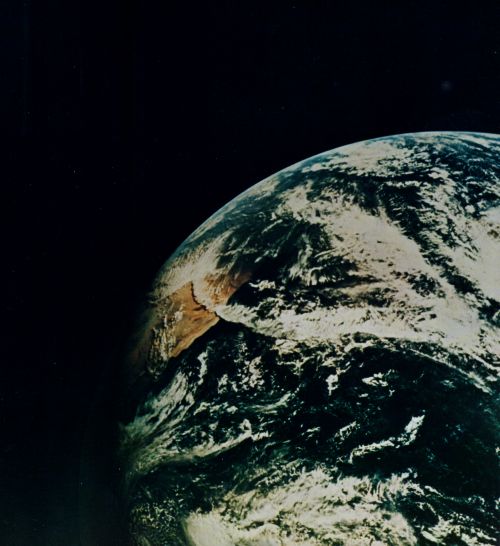|
|
|
| “Houston, this is Apollo 8.” | |
|
A brief few words, but a message which brought reasssurance to millions of anxious people the world over. Those words came on a radio signal, across thousands of miles through the harsh expanse of outer space, and with each new message another step was acknowledged in the successful progress of the greatest adventure ever experienced by man. |
|
 |
The three and one-half decades that have passed since Collins Radio was established have been years packed with history. And equipment designed and made by Collins has played a role in many events during these years. Few happenings, however, have had the dramatic impact of three men in a spaceship orbiting the moon. Those words came on a radio signal, across thousands of miles through the harsh expanse of outer space, and with each new message another step was acknowledged in the successful progress of the greatest adventure ever experienced by man. The three and one-half decades that have passed since Collins Radio was established have been years packed with history. And equipment designed and made by Collins has played a role in many events during these years. Few happenings, however, have had the dramatic impact of three men in a spaceship orbiting the moon. Communications on Apollo 8, for which Collins held major responsibilities, brought not only the voices of the astronauts and TV pictures from space to a waiting world, but also handled vast amounts of engineering data needed to conduct such a complex mission. Collins systems, both in the spacecraft and on earth, were in operation throughout the mission. The spacecraft system, officially known as the Communication and Data System, provided voice communication for astronauts with earth and intercommunication for the Apollo crew; ranging information used in tracking the spacecraft; data transfer between spacecraft and earth; television transmission from spacecraft to earth; recording of voice and transmitting the recorded information to earth when communication was reestablished; and direction finding signals and voice communication during recovery. |
|
The Collins system was installed in the lower equipment bay of the Command Module. In later flights involving both the Command Module and Lunar Module, the latter being the lunar landing vehicle, the system will also provide communication between the two spacecraft. The Communication and Data System consists of ten units of equipment for communication on both VHF and Unified S-band frequencies. VHF is used for near-earth, recovery, and Command Module to Lunar Module communications. Unified S-band is the communication link for deep space (several thousand miles out from earth and beyond), and also is used for the near-earth communication. Unified S-band is a new system introduced for Apollo, combining transmission of ranging, voice and data signals on a single frequency. Television and recorded voice are transmitted on another Unified S-band frequency. Simultaneous transmissions can be made on the single up-link and two down-link Unified S-band frequencies, with the composite signals combined and separated automatically by spacecraft or ground station systems. Collins, along with a team of sub-contractors, provided the Communications and Data System under contract to North American Rockwell Corporation, builder of the Apollo Command and Service Modules for NASA's Manned Spacecraft Center. Providing the Ground Link with the spacecraft in Apollo missions is the Unified S-band communication/tracking system, a part of the NASA Manned Space Flight Network spread around the earth. There are 14 Unified S-band ground stations, three of them equipped with 85-foot diameter antennas, and 11 of them with 30-foot diameter antennas. These are supplemented by specially instrumented ocean ships and Apollo Range Instrumentation Aircraft (ARIA). For Apollo 8, four ships and six aircraft were in the network. |  Apollo ground tracking station on the Hawaiian island of Kauai was designed, constructed and installed by Collins Radio Company and a team of subcontractors for NASA |
 Command Module communication and data system undergoes a carefully controlled electronic laboratory system test at Collins Radio, Cedar Rapids. |
The Unified S-band stations track the spacecraft, transmit and receive voice and data between earth and spacecraft, compute information, and receive TV signals from the spacecraft. The 30-foot antenna stations, ships and aircraft provide earth orbital and near-earth communication with the spacecraft. The 85-foot stations provide the deep space link. In Apollo 8, the 85-foot stations took over the tracking and communication functions when the spacecraft reached an altitude of about 10,000 miles, and continued that role until the spacecraft was again near earth. The 85-foot stations are located at Goldstone, Calif.; Madrid, Spain; and Canberra, Australia; Guam; Hawaii; Guaymas, Mexico, and Corpus Christi, Texas. Collins and a team of subcontractors designed, equipped and installed the 30-foot antenna stations; provided systems for the 85-foot antenna stations and backup stations; and provided partial systems for the instrumentation ships under a contract with NASA's Goddard Space Flight Center. The Unified S-band stations are linked to the Apollo Mission Control Center at Houston by facilities of the elaborate NASA Communications Network (NASCOM), headquartered at Goddard and connected to distant points by landline, ocean communication satellite and short wave radio. A spacecraft, whether just above the earth or many thousands of miles out in space as was Apollo 8, has only one link with earth - radio communications. |
|
The success of the communications system used in Apollo 8 was another in a series of space achievements for Collins. The Company's equipment has transmitted the voice of every astronaut who has flown in the Mercury, Gemini and Apollo Programs. The Apollo 8 crew of Frank Borman, James Lovell and William Anders are the first of a new breed of pioneers to leave earth's gravity and observe another heavenly body at a close range. But they will be followed by many others as man continues to develop and use his technological and scientific capabilities in exploring the universe. |
|
| —Collins Signal, Issue 68, Volume 17-1, 1969 - Pages 15-17 | |